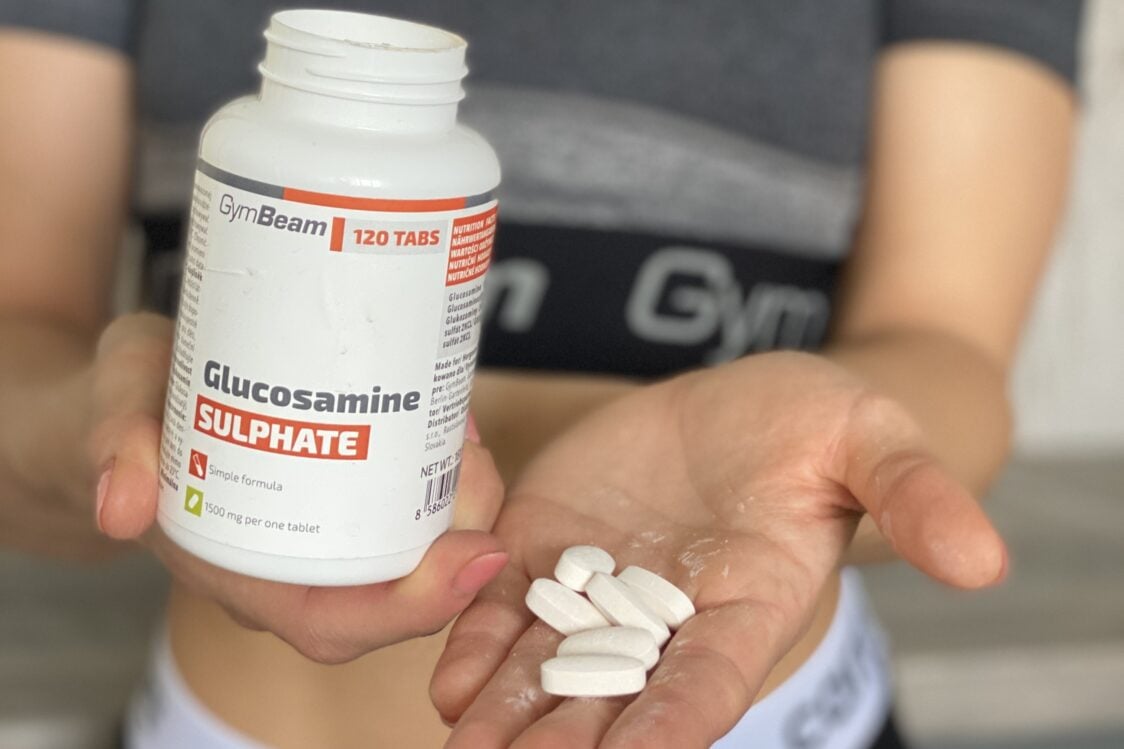Table of Contents
Are you experiencing the discomfort of stiff joints or dealing with persistent knee pain on a daily basis? If so, you’ve likely pondered whether it’s time to explore high-quality joint supplements. Glucosamine stands out as one of the potential candidates. How do scientists perceive its effectiveness, and is it truly worth incorporating into your routine?
In this article, you will learn about the impact of glucosamine on:
What is Glucosamine?
Glucosamine is a widely favoured active ingredient in the realm of dietary supplements, particularly for the health of the musculoskeletal system. Its popularity is well-deserved, given its reported benefits such as relieving joint pain and enhancing mobility and resilience. Many individuals find these effects valuable, especially considering that conditions like knee pain can be bothersome both in youth and later years, affecting even those engaged in sports.
This substance is primarily found in almost all parts of the human body. However, it is most abundant, similarly to the well-known chondroitin, in cartilage and connective tissues such as tendons and ligaments. It provides these components of the musculoskeletal system with elasticity and resilience.
It is commonly found in joint supplements, either on its own or in combination with other substances. In addition to glucosamine, the foundation of comprehensive joint supplements typically includes chondroitin, and MSM (methylsulfonylmethane), as their effects complement each other. [7]

How Does Glucosamine Function?
Before glucosamine reaches the cartilage or ligaments, it must go through the digestive system, be absorbed into the bloodstream, and then pass through the liver. Only after this journey can it begin to fulfil its role in the body. At this point, the body can use it to produce glycosaminoglycans, which are a fundamental building component of cartilage. Joint cartilage covers the ends of bones, serving as their flexible and sturdy protection. It prevents the bones from touching and rubbing against each other. Therefore, glucosamine plays a crucial role in maintaining healthy joints by contributing to the preservation of cartilage. [7,17,23]
You might be interested in these products:
What Health Benefits Does Glucosamine Have?
1. It aids in the therapy of osteoarthritis
Osteoarthritis is a degenerative joint condition in which the tissues, such as cartilage, bones, tendons, or ligaments, gradually undergo damage over time. For instance, the cartilage gradually diminishes and thins, leading to pain or reduced joint mobility. This form of arthritis typically affects joints like knees, hips, or finger joints, manifesting through pain, stiffness, or swelling. [2,20]
Currently, there are no medications that can cure osteoarthritis. However, there are several medicinal preparations and dietary supplements available that help alleviate its symptoms or slow down its progression. Glucosamine is precisely one of the substances where research indicates these effects. In fact, one study even revealed that the use of glucosamine in individuals with osteoarthritis helped delay the complete replacement of a damaged joint with a prosthesis (artificial joint) in 57% of patients, extending it by up to 5 years. [3,23]
This is a supplement that can be beneficial for knee or hip joint osteoarthritis. Research also mentions its potential effect on this condition developed in the temporomandibular joint (jaw joint). If you are troubled by this condition, then glucosamine could be one of the aids that helps you combat it. However, if you are experiencing joint pain, it’s always necessary to undergo a comprehensive examination and consult with a doctor about the course of action. [5]

2. It exhibits anti-inflammatory effects
Studies examining this dietary supplement also highlight its anti-inflammatory properties. For example, it helps to suppress the formation of substances that lead to inflammation, which is beneficial for joints. This is because pain, swelling, or stiffness are common manifestations of this condition. Thanks to its anti-inflammatory effects, glucosamine can be helpful in maintaining joint health and resilience. [7,17,23]
3. It influences the health and function of joints
Research suggests that the use of glucosamine brings about several promising benefits for joint health. Its positive effects are evident, attributed to its influence on cartilage structure and its anti-inflammatory properties.
- Studies describe a positive effect on preserving the structure of cartilage.
- Better joint mobility is also evident.
- Its use may help alleviate joint pain. One study conducted by scientists from Poland highlighted this effect, even in the case of knee pain caused by exercise and sports. [23,25]
These effects can thus come in handy to people with developed joint conditions, athletes and individuals with physically demanding jobs whose joints undergo excessive strain due to rigorous training, as well as to those trying to prevent joint issues.
4. It affects collagen production
Scientists also note that glucosamine has a positive influence on collagen, the primary structural protein found in connective tissues, cartilage, and bones. Research indicates that it may directly contribute to collagen formation while also assisting in preventing its degradation. The use of glucosamine can thus prove beneficial for joint health and vitality, as well as for maintaining resilient skin, hair, and nails. One specific form of glucosamine — N-acetyl glucosamine, is utilized in the body to produce hyaluronic acid, a crucial component for skin health. It acts as a defence against free radicals and plays a significant role in the healing process. [1,8,23]
Learn more about collagen and its effects on joints and skin in the article: How to Choose the Best Collagen for Healthy Skin and Joints?

5. Additional promising effects of glucosamine
In addition to its well-established impact on joints and connective tissues, glucosamine is also being explored in connection with other aspects of health. What are these?
- Research suggests that glucosamine could have a positive impact on blood sugar levels (glycaemia). In some studies, this effect was observed in individuals with impaired glucose tolerance or insulin resistance. [6]
- Similarly, its effects on the digestive system are evident. For instance, studies describe fewer issues with bloating or constipation. [19]
- Some scientific papers have also described a potential effect of glucosamine in relieving lower back pain. [13]
However, these aforementioned effects are currently insufficiently explored, and further studies are needed to confirm them conclusively. That said, if you decide to take glucosamine, you may still be pleasantly surprised by these intriguing potential benefits.
Discover our bestsellers:
What Are the Different Forms of Glucosamine?
Glucosamine comes in three forms, with dietary supplements primarily utilizing two of them — glucosamine sulfate and glucosamine hydrochloride. What are the differences between these individual variants?
- Glucosamine sulfate is the most extensively studied form of glucosamine and has demonstrated the highest effectiveness. It appears to be more readily absorbed compared to other forms. [24]
- Glucosamine hydrochloride is the second most commonly used form, but it shows less convincing effects on the body compared to the sulfate form.
- N-acetyl glucosamine is crucial for the production of hyaluronic acid. It is also the rarest form found in dietary supplements from among all variants.
According to research, the different forms of glucosamine vary in effectiveness, but in practice, there are no significant differences. Therefore, if you decide to supplement glucosamine, make sure to pay attention primarily to proper dosage according to recommendations rather than its form.

Does Glucosamine Have Any Adverse Effects?
The use of glucosamine is not linked to any significant adverse effects. However, excessive doses may result in symptoms such as nausea, diarrhoea, abdominal pain, or heartburn. Overall, it is considered a safe dietary supplement with ample support from various studies. [15,16]
When Is It Appropriate to Take Glucosamine?
- In the therapy of osteoarthritis: While there are currently no medications that can cure this condition, various approaches are used to improve joint function and reduce pain. Glucosamine can be utilized as part of this supplementary therapy, which is recommended by entities like the European Society for Clinical and Economic Aspects of Osteoporosis and Osteoarthritis (ESCEO). ESCEO emphasizes that the most effective form is glucosamine sulfate, found in prescription medications. This is mainly due to the guaranteed content of the active ingredient and quality. However, high-quality products can also be found among dietary supplements from reputable sports nutrition manufacturers. [16]
- Athletes: Active individuals engaged in strength, endurance, and other sports face intense activities that put strain on their joints. Therefore, it is ideal for them to strive to maintain joint function and health.
- People with physically demanding jobs: Joints also get stressed during work that involves demanding and repetitive manual tasks. Workers in construction or warehouses, for example, constantly lift or carry heavy objects and spend their working hours in motion or standing, putting great strain on the musculoskeletal system.
- Elderly individuals: Joint problems typically arise with advancing age, and suitable joint supplements should therefore ideally be a part of the medicine cabinet during this stage of life.
- Overweight and obese people: Excessive body weight puts a significant strain on the joints, especially the knees. In this case, a fundamental approach involves a reduction diet with a reasonably set caloric deficit to alleviate the burden on the stressed joints. However, joint supplements can also become a useful option in such cases.

Does It Make Sense to Take Glucosamine?
The effects of glucosamine supplementation on the body and joints are still being explored. While some studies may not be fully convinced of its effectiveness, the general consensus is that using this supplement can offer benefits. It’s something to think about if you’re dealing with joint issues or aiming to prevent them. Plus, the European organization overseeing joint disorder treatment practices recommends incorporating it into osteoarthritis therapy.
Different research outcomes may be related to factors such as the use of different forms of glucosamine, varying quality of supplement manufacturing, and differences in the methodology and quality of individual studies. Therefore, it is crucial to emphasize the quality of products and choose the most reputable ones. If you regularly subject your joints to strenuous physical activities and want to provide them with quality care, taking this supplement is certainly a step in the right direction.
In caring for your joints, remember that glucosamine is not the only thing they need. Healthy joints also depend on proteins, healthy fats, vitamins, and minerals. Achieving an adequate intake of these nutrients can be accomplished through a diverse and balanced diet. Additionally, the musculoskeletal system requires sufficient physical activity, so don’t forget to engage in regular exercise to build its resilience.

How Much Glucosamine Should You Take?
The typical daily dose of glucosamine is 1,500 mg. It is generally recommended to take this amount either all at once or to split it into three doses of 500 mg each. [7]
Some studies, particularly those involving athletes, have used daily intakes ranging from 2,000 to 3,000 mg, divided into several smaller doses. Therefore, if you are an athlete with a highly demanding training program, this strategy may be beneficial for you. [25]
There isn’t a precise recommendation on the duration of glucosamine supplementation at the moment. Studies have looked at periods ranging from several weeks to around 3 years. It seems that consistently taking glucosamine over an extended period, perhaps for 2 to 3 years, may yield more effective results. [9]
When to Avoid Taking Glucosamine?
Although glucosamine is considered a safe dietary supplement, there are certain situations in which it’s advisable to avoid using it.
- Pregnant and breastfeeding women should avoid taking this supplement, as there is insufficient research to assess the impact of glucosamine on health during this period of life.
- Children should also avoid taking it for the same reason.
- People with a shellfish allergy may experience a reaction to glucosamine, as it is commonly derived from the shells of these animals. Scientific opinions vary, so it likely depends on the specific product. If you have this allergy, it’s advisable to consult with a doctor before taking glucosamine. [21]

Can Glucosamine Interact With Medications?
While there isn’t a clear recommendation to avoid glucosamine supplementation with specific medications, some studies suggest that it may not interact well with certain drugs. If you are currently taking any of these medications, it’s important to discuss the potential interaction with your doctor before considering glucosamine supplementation.
- Blood-thinning medications, such as warfarin or aspirin, may interact with glucosamine, potentially leading to excessive bleeding.
- There is also discussion about the interaction with antidiabetic drugs or NSAIDs (nonsteroidal anti-inflammatory drugs) like aspirin or ibuprofen. [14,15]
What Can Glucosamine Be Combined With?
Glucosamine is not the only popular dietary supplement people take to improve the health of their joints. There are also several others, which, along with glucosamine, are collectively referred to as chondroprotectives. Each of them has a slightly different effect on the body, which is why they are most commonly found on the market in various combinations.
- Chondroitin sulfate is also naturally present in cartilage and helps care for its strength while maintaining hydration. [10]
- MSM (methylsulfonylmethane) is a molecule that has anti-inflammatory and antioxidant effects. [4]
- Hyaluronic acid is an essential component of synovial fluid, which acts as a ‘joint lubricant’ and contributes to smooth joint movements. [18]
- Collagen, encountered in the form of hydrolysed or non-hydrolysed (unbroken) collagen, is the main structural protein of cartilage, skin, and other tissues. It is used in joint care or skincare. [12]
- Shark cartilage contains numerous active ingredients derived from the cartilage of sharks.
- Boswellia serrata is an exotic tree, and its resin has been recognized in Ayurveda for its potential anti-inflammatory properties. [11]
- Vitamin C is an essential substance that the body needs for collagen production.
- Omega-3 fatty acids are known for their anti-inflammatory properties.
A reliable joint supplement usually incorporates key elements like glucosamine, chondroitin, and MSM, accompanied by other active ingredients, vitamins, and minerals. Opting for comprehensive supplements like the Articular Drink or ArthroComplex Drink allows you to harness the combined benefits of multiple active ingredients.
If you’re interested in how to choose the right joint supplement or how to put it together, read our article: How to Choose the Best Joint Supplement?
What Are the Main Takeaways?
Glucosamine is one of the main active ingredients found in joint supplements. Nowadays, we understand that it can contribute to maintaining healthy cartilage and joint function, and it’s even used in the therapy for osteoarthritis. This makes it a promising dietary supplement that, in combination with other active ingredients, can aid in joint care for athletes, elderly individuals, or just about anyone striving to keep their joints healthy and resilient for as long as possible.
If our article captured your interest and provided you with new insights, we would be grateful if you shared it with your friends and family.
[1] BISSETT, D.L. Glucosamine: an ingredient with skin and other benefits. – https://onlinelibrary.wiley.com/doi/10.1111/j.1473-2165.2006.00277.x
[2] BRANCH, N.S.C. and O. Osteoarthritis. – https://www.niams.nih.gov/health-topics/osteoarthritis
[3] BRUYÈRE, O. et al. Efficacy and safety of glucosamine sulfate in the management of osteoarthritis: Evidence from real-life setting trials and surveys. – https://www.sciencedirect.com/science/article/pii/S0049017215002899
[4] BUTAWAN, M. et al. Methylsulfonylmethane: Applications and Safety of a Novel Dietary Supplement. – https://www.ncbi.nlm.nih.gov/pmc/articles/PMC5372953/
[5] DAMLAR, I. et al. Effects of glucosamine-chondroitin combination on synovial fluid IL-1β, IL-6, TNF-α and PGE2 levels in internal derangements of temporomandibular joint. – https://www.ncbi.nlm.nih.gov/pmc/articles/PMC4464914/
[6] DOSTROVSKY, N.R. et al. The effect of glucosamine on glucose metabolism in humans: a systematic review of the literature. – https://www.oarsijournal.com/article/S1063-4584(11)00020-3/fulltext
[7] GUERRINI, G. Glucosamine Research Analysis. – https://examine.com/supplements/glucosamine/
[8] IGARASHI, M. et al. Effect of glucosamine on expression of type II collagen, matrix metalloproteinase and sirtuin genes in a human chondrocyte cell line. – https://pubmed.ncbi.nlm.nih.gov/28035358/
[9] LEE, Y.H. et al. Effect of glucosamine or chondroitin sulfate on the osteoarthritis progression: a meta-analysis. – https://pubmed.ncbi.nlm.nih.gov/19544061/
[10] MICHAUX, M. Chondroitin Research Analysis. – https://examine.com/supplements/chondroitin/
[11] PATEL, K. Boswellia Research Analysis. – https://examine.com/supplements/boswellia/
[12] PFIFFNER, M. Type-II Collagen Research Analysis. – https://examine.com/supplements/type-ii-collagen/
[13] SODHA, R. et al. The use of glucosamine for chronic low back pain: a systematic review of randomised control trials. – https://www.ncbi.nlm.nih.gov/pmc/articles/PMC3686234/
[14] Glucosamine Interactions Checker - Drugs.com. – https://www.drugs.com/drug-interactions/glucosamine.html
[15] Glucosamine Sulfate - StatPearls - NCBI Bookshelf. –
[16] Glucosamine sulphate: an umbrella review of health outcomes – https://www.ncbi.nlm.nih.gov/pmc/articles/PMC7768322/
[17] Glucosamine: Uses, Interactions, Mechanism of Action | DrugBank – https://go.drugbank.com/drugs/DB01296
[18] Hyaluronic Acid benefits, dosage, and side effects. – https://examine.com/supplements/hyaluronic-acid/
[19] Impact of Glucosamine Supplementation on Gut Health – https://www.ncbi.nlm.nih.gov/pmc/articles/PMC8308242
[20] Osteoarthritis. – https://www.who.int/news-room/fact-sheets/detail/osteoarthritis
[21] Shellfish allergy | AAAAI. – https://www.aaaai.org/tools-for-the-public/conditions-library/allergies/shellfish-allergy-can-be-dangerous
[22] Supplementing for better joint health - Examine. – https://examine.com/articles/supplementing-for-better-joint-health/
[23] What are glucosamine’s main benefits? - Examine. – https://examine.com/supplements/glucosamine/faq/what-are-glucosamines-main-benefits/
[24] What is the difference between the various forms of glucosamine? - Examine. – https://examine.com/supplements/glucosamine/faq/what-is-the-difference-between-the-various-forms-of-glucosamine/
[25] MOMOMURA, R. et al. Evaluation of the effect of glucosamine administration on biomarkers of cartilage and bone metabolism in bicycle racers. – https://pubmed.ncbi.nlm.nih.gov/23358550/


Add a comment